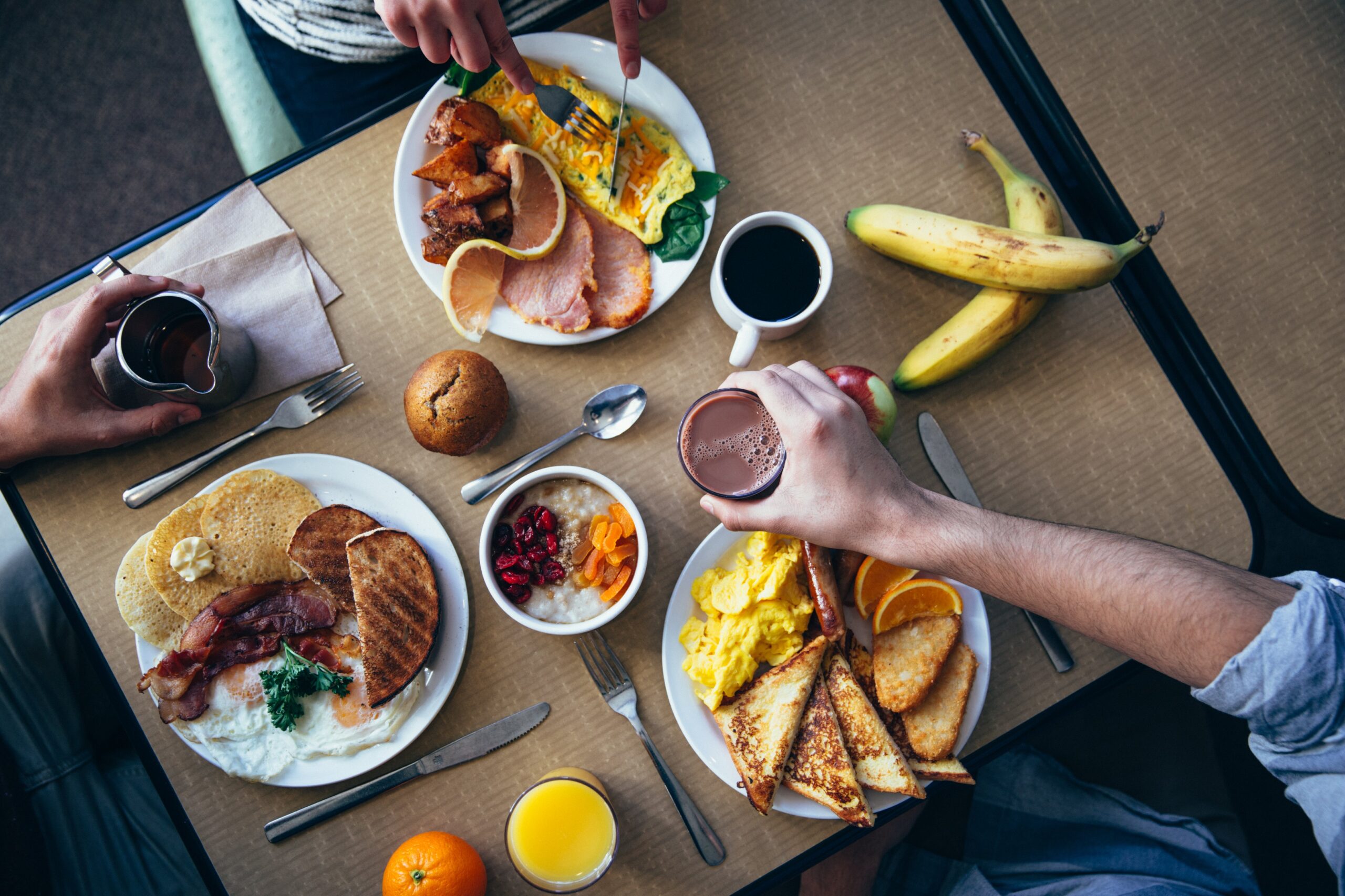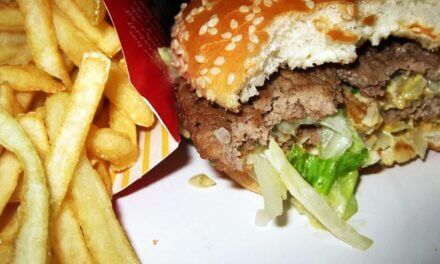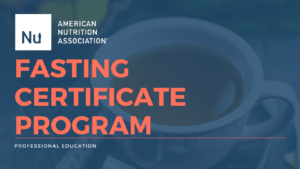Why We Really Overeat

Overeating may be seen as just a lack of self-control, but the underlying reasons that lead to overeating are much more complicated than you think. How much we eat involves several systems within the body and even some external factors that seem out of our control. If you’re wondering why you may be overeating, understanding the reasons behind it may help you gain some control.
What is Overeating?
At its most basic definition, overeating occurs when your intake of food and/or calories is greater than what your body can use. We have all overeaten at some point in our lives- whether at an event, while relaxing or as a comfort, or even just to have something to do with our hands.
In extreme cases, frequent episodes of overeating (with other criteria) may be classified as binge-eating disorder, the most common eating disorder in the US. [1,2]
Normal Satiety Response
Before we get into the details about why we overeat, let’s take a look at how our bodies regulate hunger and satiety.
Appetite and satiety are largely controlled by a complex feedback system involving hormones, peptides, amount of food eaten, and nutrient composition of foods between the hypothalamus in the brain and the digestive tract. The two most important hormones in this feedback system are ghrelin and leptin. [3]
Ghrelin is commonly known as the “hunger hormone.” It’s secretion is increased prior to meals. This gastric peptide is released from the stomach and stimulates an area of the hypothalamus, which then triggers the hunger response. [4]
Leptin is released in opposition to ghrelin to promote satiety. It is a hormone that is primarily produced by fatty tissues, then acts on the hypothalamus to begin the fullness or satiety response. [3]
In addition to ghrelin and leptin, there are other short-acting and long-acting compounds that signal hunger and satiety. Cholecystokinin (CCK) is released from the digestive tract when certain macronutrients are consumed. [5] Amylin, glucagon and insulin are released from the pancreas in response to food intake and also help with satiety. [6]
Further down in the intestinal tract, peptide YY (PYY) and glucagon-like peptide-1 are secreted after meals. Compared to CCK, these peptides can remain elevated for up to 6 hours after a meal, helping maintain longer satiety between meals. [5]
As mentioned earlier, the volume and nutrient composition of foods affect satiety. Greater volume of food affects the amount of pressure the stomach feels. When the stomach feels an adequate amount of pressure, the vagus nerve is stimulated and sends a response to the brain to decrease appetite.
In addition to the volume of food, consuming high-calorie meals, or meals with high fat and/or protein content slows down the movement of food in the stomach. This maintains the volume-sensitive signaling pathway of satiety. [7]
Together, these systems maintain balance in the body and control hunger and satiety. There are physiological conditions that may disrupt this balance – including chronic disease, leptin resistance or leptin deficiency, disordered eating patterns, mood disorders, rheumatoid arthritis, and Prader-Willi Syndrome. [3]
How we Override Satiety
We are generally born with the innate ability to feel when we are hungry or full, but that may be more difficult for us to manage as we become older. Dysregulating our body’s natural ability to determine hunger and satiety can happen as early as infancy.
Within the first year of life, there are outward signs that infants show to indicate fullness or hunger. If a child is full, they may close their mouth, turn away from a bottle, food or breast, push food away, or make noises or gestures that they don’t want to eat. When hungry, an infant may smack lips, put their hands to their mouths, reach for food or get excited around food, or even make gestures and noises to indicate they are hungry. [8]
Parents and guardians are encouraged to pay attention to those cues to allow children to develop trust in their bodies and autonomy in eating. When these hunger cues are ignored, it can contribute to overeating later on in life.
Infants who are formula-fed may be at greater risk for overfeeding due to increased parental control over intake – for example, encouraging an infant to finish a bottle even if they are exhibiting signs of fullness. Research finds that without additional parental influence, infants are able to self-regulate intake of formula so that caloric intake is generally stable. [9]
When children are able to eat meals, this ability to self-regulate intake continues. Depending on the caloric density or macronutrient intake at a single meal, children self-regulate intake between meals. Parents and guardians who encourage intake based on external cues such as rewards for eating or “cleaning the plate” may decrease a child’s ability to gauge hunger based on internal cues. [9]
Now that we know where some of the origins of overeating are, let’s talk about further behaviors we develop over time that may increase our overeating.
Hedonic Hunger
Hunger primarily exists as a way to remind our bodies to obtain food, but not all eating is motivated by physiological needs. Hedonic hunger is a type of hunger that is motivated by pleasure and rewarding systems within the brain.
Hedonic hunger corresponds to increased motivation to eat highly palatable foods (usually foods rich in sugar, fat, and/or salt). The “Power of Food Scale” (PFS) used in research to help measure the presence of hedonic hunger behaviors finds that individuals with higher PFS scores have higher anticipation and intention towards eating highly palatable foods.
Researchers note that hedonic hunger may not consistently increase intake by itself, but when combined with other character traits like impulsivity may increase food consumption. Hedonic hunger has also been connected to feelings of “loss of control” over eating, a feature of disordered eating. [10]
People often joke about gaining weight during vacations, holidays, and other celebrations but there is an association between festive times and overeating. Hedonic eating plays a role in this – many foods consumed during these times are highly palatable, or are highly anticipated due its infrequent appearance on the menu. Gathering for celebrations also increases social eating, and may distort perceived norms for portion sizes.
In a study of social norms and portion sizes, researchers wanted to see if perceived social norms could affect the portion size effect. Participants were allowed to indicate the amount of food that they would eat or serve themselves from a selection of food, and then were told either a minority or majority of similar individuals approved of their portion size.
The participants ate larger sizes if they thought that the majority of people approved of the portion size, and slightly modified their portions if they thought only a small amount of people approved. The results of this study indicate that social acceptance and sense of belonging may influence intake to some degree. [13]
Emotional Eating
A variety of emotions can trigger emotional eating, whether it is a response to stress, in celebration, or as a coping mechanism.
Stress triggers the production of cortisol, which is a glucocorticoid, in the body. Increased levels of glucocorticoids have been associated with greater intake of carbohydrate and protein foods. Individuals with a high stress response (higher cortisol release) have a greater intake of snacks or other foods that are rich in fat and sugar.
One study found a direct relationship between experiencing daily hassles and snack intake, especially among the pre-menopausal women who had a high cortisol reaction to stress. [11]
Negative emotions may also trigger overeating as a coping response. This is often seen in individuals who have a low distress tolerance, defined as a limited ability to handle aversive emotional states (e.g., guilt, distress, grief, or low mood). Distress may also trigger emotional eating in people who are chronic dieters compared to those who are not chronic dieters, regardless of the palatability of the food. [12]
Distracted Eating
Have you ever gone to the movie theater and eaten half of your popcorn before the opening trailers were finished? Or had a snack nearby to munch on while working on a project, only to realize that you’ve eaten more than you wanted to? You don’t mean to eat that much, but you end up doing so anyway – here’s why:
Memory is important in making decisions about food, not only while you’re eating it, but afterwards as well. Working memory, a memory process that is important for decision-making and behavior, helps us pay attention to food and what kinds of foods we want to eat. This process can help us regulate our satiety response and how much we eat – when we don’t pay attention, we tend to eat more food.
Episodic memory is another process for decision-making that influences future intake by adapting behaviors and food motivations. In one study, individuals who were able to remember what they ate for lunch were less likely to eat an afternoon snack. Other studies confirm that being able to remember a recent meal inhibits later food intake.
Individuals with damage to the hippocampus with resulting memory deficits or those with amnesia tend to eat more without a change in appetite. A research group found that those with good hippocampal-dependent memory performance were less likely to desire highly palatable foods when feeling sated. Uncontrolled eating habits may also be associated with poor episodic memory. [14]
Highly Palatable Foods
The term “highly palatable foods” is exactly what it sounds like – foods that taste good, activate the reward system in the brain, and make you want to eat them more. To be specific, highly palatable foods are usually those that are high in fat, sugar, and salt. It doesn’t always have to be, but these foods are typically processed or ultra-processed foods.
Foods that are considered highly palatable affect normal satiety response by activating endogenous opioids, dopamine, and serotonin in the brain. These hormones act upon the hypothalamus which slows down the satiety response in the body. A decreased satiety response allows one to eat more food in a single sitting, which may lead to overeating and increased weight. [15]
Human and animal studies support the role of food palatability on increasing short-term intake of food. There is a need for more research to determine if intake of highly-palatable foods directly causes weight gain in humans. [16]
Portion Distortion
Research suggests that a prominent cause for overeating is due to the portion size effect. The portion size effect in essence suggests that offering large portions of food at meals can drive overeating from external cues. A review of studies looking at obesity and portion size noted that episodes of overeating associated with large portions are sustained without compensatory reduction in energy intake. [17]
In one study published in the journal Psychology & Health, participants were served a large or small portion of pasta and later asked to compare the portion they ate in comparison to how they normally ate. Those who reported that they ate more than usual believed that their intake was related to external cues (the amount available on the plate). [18]
Why We Overeat–A Conclusion
Overall, there are many reasons why we may overeat – some of them are psychological and some are physiological. Our behaviors around eating and potential overeating can start as early as our infancy, but it does not mean that we are doomed if we have some overeating tendencies.
We can relearn how to maintain our internal hunger cues by monitoring our intake of highly-palatable foods without deprivation, trying alternative coping methods to deal with stress and emotional distress, reducing distractions when we eat, and learning proper portion sizes to reduce the effects of portion distortion.
If you have concerns about your eating patterns, please consult your physician or other medical professional like a dietitian or psychologist who specializes in the management of overeating behaviors to help you with making healthy choices.
Read More:
- Management and outcomes of binge-eating disorder
https://www.ncbi.nlm.nih.gov/books/NBK338301/table/introduction.t1/ - The prevalence and correlates of eating disorders in the National Comorbidity Survey replication
https://www.ncbi.nlm.nih.gov/pmc/articles/PMC1892232/ - Physiology, Obesity, Neurohormonal Appetite and Satiety Control
https://www.ncbi.nlm.nih.gov/books/NBK555906/ - Ghrelin: much more than a hunger hormone
https://www.ncbi.nlm.nih.gov/pmc/articles/PMC4049314/ - Intestinal feedback signaling and satiety
https://www.ncbi.nlm.nih.gov/pmc/articles/PMC3143258/ - Pancreatic signals controlling food intake; insulin, glucagon, and amylin
https://www.ncbi.nlm.nih.gov/pmc/articles/PMC1642707/ - Hunger games: is your stomach making you fat
https://www.gastrojournal.org/article/S0016-5085(15)00095-5/fulltext - Signs your child is hungry or full
https://www.cdc.gov/nutrition/infantandtoddlernutrition/mealtime/signs-your-child-is-hungry-or-full.html - Development of eating behaviors among children and adolescents
https://pediatrics.aappublications.org/content/101/Supplement_2/539.long - A narrative review of the construct of hedonic hunger and its measurement by the Power of Food Scale
https://www.ncbi.nlm.nih.gov/pmc/articles/PMC6009994/ - Daily hassles and eating behaviour: the role of cortisol reactivity status
https://pubmed.ncbi.nlm.nih.gov/17198744/ - Distress and eating: why do dieters overeat?
https://pubmed.ncbi.nlm.nih.gov/10422604/ - The role of social norms in the portion size effect: reducing normative relevance reduces the effect of portion size on consumption decisions
https://www.frontiersin.org/articles/10.3389/fpsyg.2016.00756/full - Cognitive control of eating: the role of memory in appetite and weight gain
https://europepmc.org/article/pmc/5829122 - The influence of palatable diets in reward system activation: a mini review
https://www.hindawi.com/journals/aps/2016/7238679/ - Variety, palatability, and obesity
https://www.ncbi.nlm.nih.gov/pmc/articles/PMC4224225/ - Portion sizes and obesity
https://www.ncbi.nlm.nih.gov/pmc/articles/PMC4224223/ - Self-reported overeating and attributions for food intake
https://pubmed.ncbi.nlm.nih.gov/28135848/
Author:

Markita Lewis, MS, RD
Markita has an interest in the biological, social, and cultural aspects of eating. She enjoys writing about nutrition and wellness, food justice and policy, cultural foodways, and the psychology of nutrition. You can find her at: www.wellnessandchill.com





